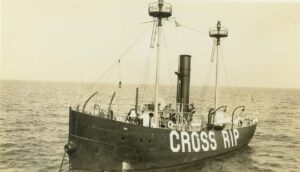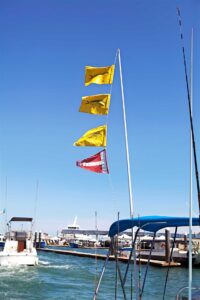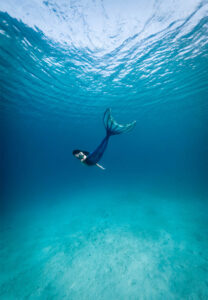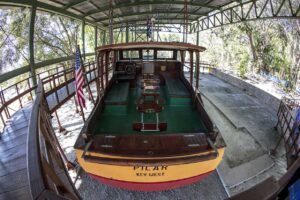
Mornings at the home on 907 Whitehead Street in 1930s-era Key West were filled with the faint sounds of a pencil on paper or fingers flicking the keys on a Royal-brand typewriter. By early afternoon, this illustrious inhabitant had finished his work for the day, satisfied with the progress on his latest novel and went for a walk.
Sometimes, the destination was his favorite watering hole, Sloppy Joe’s. Other times, he’d head for the docks and cast off on a fishing trip aboard his beloved Pilar. Still other days, he went to the Key West Arena to referee in boxing matches featuring local fighters of Bahamian descent.
Today, it’s possible to retrace the footsteps of one of Key West’s most recognizable past residents, Ernest Hemingway. The same is true of the Bahamian island of Bimini to the north and Cuba to the south. This trio of tropical locations is where Hemingway lived and visited for more than 30 years and inspired some of the Pulitzer and Nobel prize-winning author’s works.
Born in 1899 in Oak Park, Chicago, Hemingway grew up excelling athletically and academically. High grades in English led to his first literary pursuit, as editor of his high school newspaper and yearbook. After graduation, he worked as a cub reporter for The Kansas City Star, where the periodical’s style guide shaped his writing – short sentences, short paragraphs, no slang, no superfluous words.
Over the next decade, he served as a World War I ambulance driver, a Paris-based foreign correspondent, and then transitioned from journalist to writer with the novel, The Sun Also Rises, centered on bullfighting in Pamplona, Spain. Hemingway then married his second wife, Pauline, in 1927, and the two moved back to America.
KEY WEST, FLORIDA
1928-1939
Ernest and Pauline never meant to call Key West home. The two first arrived at the southernmost town in the Continental United States on a steamship from Cuba after a long cold winter in Paris. It was April 1928.
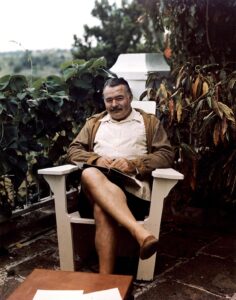
“Pauline’s Uncle Gus had bought the couple a Model A Ford, and it was supposed to be in Key West when they arrived. There weren’t the bridges we have now. Most everything was shipped in by boat or rail. The car dealer was so embarrassed the car wasn’t there that he offered Hemingway and his wife an apartment above the dealership to stay. That dealership was on Simonton Street. It was called the Trev-Mor Ford. Today the building is a private residence called Casa Antigua. Hemingway was so inspired by Key West that he finished A Farewell to Arms while staying at the apartment. Just think, if the car had been ready, he might not have lived in Key West, and it would have been a whole other story,” says Carol Shaughnessy, a 40-year Key West resident, who works with Newman PR’s Florida Keys News Bureau, and is former director of the city’s Hemingway Days festival.
Pauline’s Uncle Gus bought the Hemingways’ home on Whitehead Street for them in 1931. Originally built in 1851, the two-story Spanish Colonial-style house undertook a massive restoration and remodeling that included the addition of a pool in the late 1930s. Today, the Hemingway Home is a National Historic Landmark, open for daily tours.
“His writing studio probably was his favorite room. He was able to get out of bed in his master bedroom and walk across the catwalk and start his day writing. He would continue writing until around noon,” says Alexa Morgan, director of PR for the Hemingway Home & Museum, who adds that the author penned a huge portion of his life’s work here.
“Hemingway was an animal lover, so he enjoyed it when a ship captain gifted his sons a kitten and they named it Snow White,” adds Morgan. “Polydactyl cats are meant to be of good luck. A quote of his, ‘One cat just leads to another,’ is one of our favorites, since we currently have 58 (many are six- and seven-toed) cats on the property. We kept his tradition alive by naming our resident felines after famous people from Ernest’s time,” adds Morgan.
Several other Key West places to visit can pick up on the vibe of Hemingway. One of the most famous is Sloppy Joe’s Bar, now located at 201 Duval Street. Local legend tells that Hemingway drank with the owner, Joe Russell, before the bar’s official opening date of December 5, 1933, when Prohibition was repealed. Hemingway is also credited with encouraging Joe to re-name his saloon Sloppy Joe’s, in remembrance of a bar in Havana, which had ‘sloppy’ melted ice on the floor.
The Blue Heaven Restaurant, at the corner of Petronia & Thomas streets, is where Hemingway slipped in unrecognized at Bahamian boxing fights in the then-named Key West Arena. The SALT Gallery at 830 Fleming Street, a half-mile north of Hemingway’s home, was once called Mrs. Rhoda Baker’s Electric Kitchen, where he dined on 20-cent ‘club breakfasts.’
Hemingway’s passion for big game fishing ignited in Key West. He bought Pilar, a 38-foot wheeler, and often fished with Charles Thompson, who owned a hardware store at Thompson’s Docks on Caroline Street, the location of Key West Historic Seaport today. The two pushed far into the gulf stream, as well as to the Dry Tortugas, fishing for monster blue marlin and bluefin tuna. Charter boat captain Bra Saunders was at the helm on
Hemingway’s and Thompson’s first trip to the Dry Tortugas. Saunders’ gnarled hands are said to be the author’s inspiration for those of the old Cuban fishermen, Santiago, in Old Man and the Sea.
The last time Hemingway and his friends fished in the Dry Tortugas, a tropical storm marooned them for two-plus-weeks at what is now Fort Jefferson. Nowadays, a high-speed catamaran ferry takes visitors on day trips from Key West to Fort Jefferson in the Dry Tortugas National Park.
BIMINI, THE BAHAMAS
1935-1937
Hemingway’s love of fishing, bolstered by his adventurous spirit and 1933 trip to hunt big game on Africa’s Serengeti plains, enticed him to stalk giant bluefin tuna. In 1935, he first ventured to Bimini, with catches of 514- and 610-pound tuna soon to his credit.

When he wasn’t aboard Pilar, he was at his home on Alice Town’s Main Street, where only cinder rubble and a commemorative sign remain today, or at a small hotel and bar called the Compleat Angler. This hotel burned down in 2006, and with it all the Hemingway memorabilia, though a monument stands there today.
Across the way, at the Bimini Big Game Club Resort & Marina, two framed photos on the wall at the bar are real finds for Hemingway aficionados. One is a 1939-written letter from Michael Lerner, of New York’s Lerner Corporation store fame, to Hemingway, in what was initial correspondence between the two avid anglers to promote releasing rather than killing their catch. The second is Hemingway’s concurring reply.
“We don’t have a chair at the bar where we can say Hemingway sat, but the old-time Bimini vibe, the way it felt when he was here, is still very much alive,” says Stephen Kappeler, the club’s managing director. “We have guests that come to soak up that feeling of when Hemingway was here. Of course, they also come here to sport fish off their own boats as Hemingway did or on charters.”
Just west of the club off Queen’s Highway is the Dolphin House. This museum and home were hand-built from recycled materials by Ashley Saunders, a fifth generation Biminite. Saunders’ relatives boxed with Hemingway on makeshift rings on the beach. Open to the public, the museum showcases Hemingway artifacts, his sayings like “Write drunk, edit sober” on the walls, and old photos such as Pauline cutting his hair outside.
HAVANA, CUBA
1940-1960
Hemingway divorced Pauline, and with his third wife Martha, he bought a home he called Finca Vigía in the San Francisco de Paula neighborhood, about 15 miles south of Havana. The 1886 property, with its incredible view of Havana, is where Hemingway wrote The Old Man and the Sea. It’s now a museum, and the grounds are open for public tour. He and later fourth wife, Mary, enjoyed Havana’s bohemian nightclub scene in the late 1940s and 1950s with Hollywood glitterati like Spencer Tracy, Katharine Hepburn and Ava Gardner. Up until the last year of his life, Hemingway continued to sport fish.
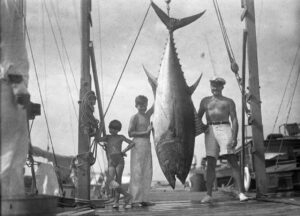
“In 1960, Hemingway last participated in an Ernest Hemingway International Billfish Tournament. It was then that he and Fidel Castro, also a participating angler, met. When we founded our Hemingway International Yacht Club in 1992, we wanted to recall the history of the former International Yacht Club of Havana, which, in 1950, organized the first Ernest Hemingway International Billfish Tournament. We have a seat of honor at the club and photos on the wall that show that meeting,” says Commodore Jose Escrich.
The area between the Morro Castle at the entrance of Havana Bay and the town east of Havana called Cojímar is known as the Hemingway Mile. Here he frequently fished aboard Pilar. Escrich says anglers competing in the tournament today catch most of their fish in this area.
Hemingway Days
Immerse yourself in the life, legend and lore of Ernest Hemingway, at the Hemingway Days festival in Key West. Set for July 19-24, 2022, to coincide with Hemingway’s birthday on July 21, the week-long celebration features a Hemingway Look-Alike Contest at Sloppy Joe’s Bar, a Running of the Bulls where contestants and past contest winners parade down Duval Street with hand-built bulls, a fishing tournament, 5K run and paddleboard race that are both a nod to Hemingway as an avid sportsman, and the Lorian Hemingway Short Story Competition, coordinated and judged by the author’s granddaughter, Lorian Hemingway. For more, go to hemingwaydays.net



